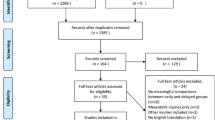Abstract
In patients with hollow viscus perforation of the abdomen, open surgery is considered as the standard approach; however, the use of laparoscopy for diagnostic purposes and treatment appears to be a safe alternative with many advantages. The present study was conducted to compare the results of laparoscopic repair versus open repair in patients with hollow viscus perforation. A total of 60 patients with hollow viscus perforation undergoing either laparoscopic (group A = 30) or open repair (group B = 30) were included in the study. Demographic data, history, and clinical characteristics of all patients were noted. The primary outcomes such as time required for surgical procedure and resumption of normal activities were noted. The mean ages of groups A and B were 48.30 ± 18.23 and 49.30 ± 15.27 years, respectively, with male preponderance. In clinical characteristics, duration of vomiting (p = 0.001) and total leukocyte count (p = 0.032) were associated significantly with incidence of hollow viscus perforation. The mean Mannheim peritonitis index score was comparable in groups A and B (22.07 ± 4.65 vs. 21.47 ± 5.39; p = 0.646). The mean duration of surgery was significantly low in group A (105.13 ± 9.57 min) compared to group B (141.67 ± 20.19 min; p < 0.001). The mean duration of resumption of daily activities was significantly low in group A (4.53 ± 0.73 days) compared to group B (11.87 ± 2.93 days; p < 0.001). Laparoscopic repair is a beneficial procedure for the management of hollow viscus perforation in terms of lower surgical time and early resumption of daily activities.


Similar content being viewed by others
References
Arulselvan A (2016) Comprehensive study of hollow viscus perforation and its management. IOSR J Dent Med Sci 1:1–4
Tim HT, Swarupjit G, Ranjit KM, Jatasankar M, Dharmendra D (2015) Clinicopathological study on hollow Viscus perforation. J Pharm Biomed Sci 5:100–103
Gopalakrishna K (2016) Clinical study of perforations of small bowel. J Endocrinol Metab Disord Diabetes South Afr 5:4154–4160
Dorairajan L, Gupta S, Deo S, Chumber S, Sharma L (1994) Peritonitis in India--a decade’s experience. Trop Gastroenterol 16:33–38
Rao M, Samee AA, Khan S (2015) Hollow viscous perforation: a retrospectum study. Intern J Sci Res 6:3250–3254
Yeo CJ, McFadden DW, Pemberton JH, Peters JH, Matthews JB (2012) Shackelford’s surgery of the alimentary tract. Elsevier Health Sciences, North Carolina
Kaiser AM, Katkhouda N (2002) Laparoscopic management of the perforated viscus. Semin Laparosc Surg 9:46–53
Robertson G, Wemyss-Holden S, Maddern G (2000) Laparoscopic repair of perforated peptic ulcers. The role of laparoscopy in generalised peritonitis. Ann R Coll Surg Engl 82:6–10
Siow SL, Mahendran HA, Wong CM, Hardin M, Luk TL (2018) Laparoscopic versus open repair of perforated peptic ulcer: improving outcomes utilizing a standardized technique. Asian J Surg 41(2):136–142
Kologlu M, Elker D, Altun H, Sayek I (2000) Validation of MPI and PIA II in two different groups of patients with secondary peritonitis. Hepatogastroenterology 48:147–151
Bosscha K, Reijnders K, Hulstaert P, Algra A, Van der Werken C (1997) Prognostic scoring systems to predict outcome in peritonitis and intra-abdominal sepsis. Br J Surg 84:1532–1534
Laforgia R, Balducci G, Carbotta G, Prestera A, Sederino MG, Casamassima G, Minafra M, Sallustio P, Palasciano N (2017) Laparoscopic and open surgical treatment in gastroduodenal perforations: our experience. Surg Laparosc Endosc Percutan Tech 27:113–115
Antoniou SA, Antoniou GA, Koch OO, Pointner R, Granderath FA (2013) Meta-analysis of laparoscopic versus open repair of perforated peptic ulcer. JSLS 17:15–22
Sreeramulu P, Venkatachalapathy T, Supreet C, Prathima S (2013) A comparative study of laparoscopic vs open surgery for the management of duodenal ulcer perforation. World J Lap Surg 6:11–14
Lunevicius R, Morkevicius M (2005) Systematic review comparing laparoscopic and open repair for perforated peptic ulcer. Br J Surg 92:1195–1207
Bertleff MJ, Halm JA, Bemelman WA, van der Ham AC, van der Harst E, Oei HI, Smulders J, Steyerberg E, Lange JF (2009) Randomized clinical trial of laparoscopic versus open repair of the perforated peptic ulcer: the LAMA Trial. World J Surg 33:1368–1373
Lunevicius R, Morkevicius M (2005) Comparison of laparoscopic versus open repair for perforated duodenal ulcers. Surg Endosc 19:1565–1571
Kirshtein B, Bayme M, Mayer T, Lantsberg L, Avinoach E, Mizrahi S (2005) Laparoscopic treatment of gastroduodenal perforations: comparison with conventional surgery. Surg Endosc 19:1487–1490
Zedan AS, Lolah MA, Badr ML, Ammar MS (2015) Laparoscopic versus open repair of perforated duodenal peptic ulcer: a randomized controlled trial. Menoufia Med J 28:62–68
Kumar P, Kumar S, Verma RK, Agarwal A, Kumari R (2016) Laparoscopic versus open repair of duodenal perforation: a comparative study in tertiary care hospital in Uttarakhand, India. Int Surg J 3:1975–1978
Domínguez-Vega G, Pera M, Ramón JM, Puig S, Membrilla E, Sancho J, Grande L (2013) A comparison of laparoscopic versus open repair for the surgical treatment of perforated peptic ulcers. Cir Esp 91:372–377
Author information
Authors and Affiliations
Contributions
The authors have contributed equally in the development of this manuscript.
Corresponding author
Ethics declarations
Conflict of Interest
The authors declare that they have no conflicts of interest.
Rights and permissions
About this article
Cite this article
Koujalagi, R.S., Kenawadekar, R., Gogate, A.S. et al. A 1-Year Randomized Controlled Study to Compare Laparoscopic Repair vs. Open Repair for the Treatment of Hollow Viscus Perforation. Indian J Surg 81, 320–325 (2019). https://doi.org/10.1007/s12262-018-1800-x
Received:
Accepted:
Published:
Issue Date:
DOI: https://doi.org/10.1007/s12262-018-1800-x




